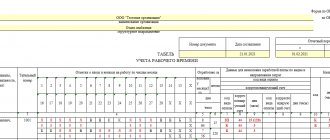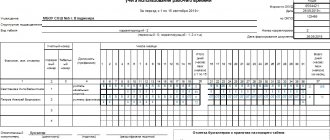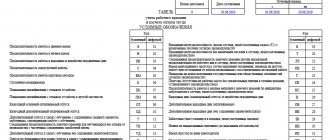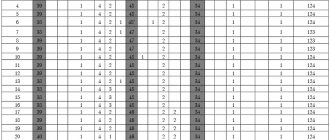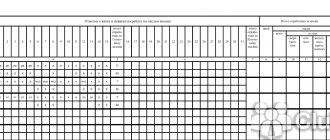Good afternoon, dear reader.
This article will discuss the work and rest schedule of drivers, regulated by law. The fact is that for several years in Russia you can receive not only a fine for the absence of a tachograph (a device that monitors the driver’s work schedule), but also a fine for violating the work and rest schedule.
However, many car drivers still do not have information about what constitutes the “correct” driving mode. This article will discuss the features of working hours and rest time, working conditions for car drivers (valid from January 1, 2022), which contain information about the driver’s working time in different situations:
- Driver work schedules.
- Driver's working hours.
- Daily recording of working hours.
- Summarized working time recording.
- Dividing working time into parts.
- Irregular working hours.
- Driving time.
- Special breaks included during work.
- Rest mode for drivers.
- Break for rest and food.
- Daily (rest between shifts).
- Weekly uninterrupted rest.
- Work and rest schedule of a commuter bus driver.
- Exceptions for drivers.
Let's get started.
Attention! This article discusses the features of the work of drivers working for hire and individual entrepreneurs. The standards for individuals are discussed in a separate article: “Regime for driving personal trucks and buses.”
Driver work schedules
First of all, you need to pay attention that special work schedules .
Work schedules are drawn up by the employer and communicated to the driver. Schedules are drawn up monthly (for a month), they reflect working days indicating the start and end times of daily work (shifts), break times for rest and meals in each shift, as well as weekly rest days.
There are 2 types of time tracking:
- Daily work time recording . The duration of each working day is within the limits established by law.
- Summarized working time recording . Working days may vary. There are long days that do not fit into the standards. However, the number of working hours per month is within the normal range.
Each of these types will be discussed in more detail below.
Standard working hours for cumulative accounting
The duration of working hours during the accounting period should not exceed the normal number of working hours, which is determined based on the weekly working hours provided for a particular category of employees.
The procedure for calculating the norm of working time for certain calendar periods of time (month, quarter, year) depending on the established duration of working time per week was approved by Order of the Ministry of Health and Social Development of Russia dated August 13, 2009 No. 588n in accordance with Part 3 of Art. 91 Labor Code of the Russian Federation.
The employer must organize the work process so that the standard working time is worked by the employee for the established accounting period. Moreover, on each day or each week of the accounting period, the duration of working hours may change. An increase in working time on any day or week is compensated by a decrease in working time on other days or weeks of the accounting period.
The exception is certain categories of workers, the duration of the working day (shift) of which cannot exceed that provided for by law, as defined in Art. 94 Labor Code of the Russian Federation.
Please note that if an employee works part-time (shift) and (or) part-time week, the normal number of working hours for the accounting period is reduced accordingly (Part 3 of Article 104 of the Labor Code of the Russian Federation).
For employees on vacation or temporarily disabled, the standard working time is reduced during the employee’s absence, since vacation and the period of temporary disability do not apply to working time (Part 1 of Article 91 of the Labor Code of the Russian Federation, letter of the Ministry of Labor of Russia dated September 1, 2021 No. 14-6/ OOG-8378, dated December 25, 2013 No. 14-2-337).
For employees on a business trip, the standard working time is reduced for the duration of the business trip, since its period, due to its functional purpose, although equal to working time, is not such. This follows from paragraph 3 of the Letter of the Ministry of Labor of Russia dated December 25, 2013 No. 14-2-337.
Summarized working time recording is used, for example, in shift work, flexible working hours, and shift work. This follows from the analysis of Part 1 of Art. 104, part 1, 2 art. 103, part 2 art. 102, part 1 art. 300 Labor Code of the Russian Federation.
Driver working hours
Let's look at what a driver's working time :
9. The driver's working time includes:
- driving time;
- time of special breaks for rest from driving (hereinafter referred to as special breaks);
- time of work not related to driving.
15. The driver's working time not related to driving a car includes:
a) preparatory and final time for performing work before leaving the line and after returning from the line, and for intercity transportation - for performing work at the turnaround point or on the way (at a parking place) before the start and after the end of the shift;
b) the time of pre-shift, pre-trip and post-shift, post-trip medical examinations of the driver, as well as the travel time from the workplace to the place of the medical examination and back;
c) parking time while waiting for loading and unloading operations, while waiting for passengers to board and disembark, while providing technical assistance;
d) downtime not due to the driver’s fault;
the time of work to eliminate any vehicle malfunctions performed by the driver independently;
e) other time provided for by the legislation of the Russian Federation, the employment contract concluded with the driver, and (or) a collective agreement or local regulatory act of the employer, adopted taking into account the opinion of the representative body of employees.
Please note there are 8 different activities listed here. This indicates that the driver should not drive the vehicle during the entire working time .
For example, if a driver has an 8-hour working day, then these 8 hours should also include time for pre-trip and post-trip medical examinations, time for rest breaks, time for boarding and disembarking passengers, etc.
Please note that some organizations may offer the driver to take rest breaks by reducing the lunch break time. It is not right.
Attention! Until December 31, 2022, the driver’s working hours also included:
- cargo security time (at least 30 percent was counted);
- time spent in the car when the car was driven by a second driver (at least 50 percent was counted).
From January 1, 2021, these operations are not included in the driver’s working hours.
Daily work time recording
When recording working hours on a daily basis, the driver works a standard 40-hour week.
Let me remind you once again that this time includes not only the time of driving.
Note. Until December 31, 2022, additional restrictions were imposed. If the driver had 5 working days, then the duration of each of them should not exceed 8 hours. If the driver had 6 working days, then each of them should not be longer than 7 hours. As of January 1, 2021, these requirements cease to apply.
Summarized working time recording
Summarized working time recording is a more complex scheme. With this scheme, the driver’s working time is calculated not for 1 day, but for a month.
Note. Until January 1, 2021, in some cases (in resort areas and seasonal transportation), it was allowed to use summarized accounting during the season . From January 1, 2022, the accounting period in all cases is 1 month. It can be increased to 3 months in agreement with the representative body of workers.
For example, in a month consisting of 31 days there are 23 working days. In this case, the driver’s total working time should not exceed 23*8 = 184 hours. However, there may be working days during which the driver works more than 8 hours.
However, there are some peculiarities here too. With cumulative accounting, the length of the working day cannot exceed 10 hours .
There are several exceptions when the working day can be increased to 12 hours :
- In the case when the driver needs to be given the opportunity to get to a vacation spot or complete the transportation.
- For bus drivers working on urban and suburban routes.
- Drivers carrying out transportation for healthcare institutions, public utility organizations, telegraph, telephone and postal communications, broadcasters of all-Russian compulsory public TV channels and radio channels, telecom operators carrying out on-air digital terrestrial broadcast of all-Russian compulsory public TV channels and radio channels, emergency services, transportation in official cars when servicing the heads of organizations, transportation in cash-in-transit vehicles, transportation in passenger taxis, as well as for drivers working as part of shift crews with a rotational method of organizing work.
Note. The list of exceptions was updated on January 1, 2021.
The procedure for introducing summarized accounting
According to Art. 104 of the Labor Code of the Russian Federation, the procedure for introducing summarized recording of working time is established by the internal labor regulations (hereinafter referred to as PVTR).
The PVTR regulates the working hours, rest periods, incentive and penalty measures applied to employees, as well as other issues of regulating labor relations with a given employer.
Summarized recording of working time at an enterprise can be introduced by order (instruction) of the employer, taking into account the opinion of the elected body of the primary trade union organization (if the enterprise has a trade union).
Summarized working time tracking can be introduced throughout the organization or for specific employees. The condition of summarized accounting must be included in the employment contract.
According to Art. 74 of the Labor Code of the Russian Federation, if the terms of the employment contract determined by the parties, related to changes in organizational or technological working conditions, cannot be preserved, they can be changed at the initiative of the employer, with the exception of changes in the employee’s labor function.
That is, if the PVTR did not initially provide for summarized recording of working time, appropriate changes must be made when applying it.
Dividing working time into parts
Note. Until January 1, 2021, working hours could be divided into parts only for bus drivers working on regular city, suburban and intercity bus routes and for drivers of official government cars.
It is possible to divide the working time of any driver into several parts. In this case, the break is scheduled no later than five hours after the start of working hours. The duration of the break is no more than:
- three hours for drivers of public transport operating in urban and suburban services;
- five hours for other drivers.
In this case, the time for rest and meals is not included in the break.
For example, in practice the following working day for a bus driver may occur:
| Driver actions | Actual time | Work time |
| Bus control | 4 hours | 4 hours |
| Break | 2 hours | |
| Dinner | 2 hours | |
| Bus control | 4 hours | 4 hours |
| Total | 12 hours | 8 ocloc'k |
This scheme can be used, for example, for a bus driver to bring employees of an enterprise and take them home. Moreover, the first part of the working time is from 7:30 to 11:30 to deliver workers by 9 o’clock, and the second part of the working time is from 15:30 to 19:30 to deliver workers who finished their shift at 18 o’clock.
Irregular working hours
The law also provides for the possibility of irregular working hours for drivers:
8. In the manner prescribed by Article 101 of the Labor Code of the Russian Federation (Collected Legislation of the Russian Federation, 2002, No. 1, Art. 3; 2022, No. 25, Art. 3594), for drivers of passenger cars (except passenger taxis), as well as for car drivers , engaged in geological exploration, topographic-geodetic and survey work in the field, irregular working hours may be established.
The decision to establish an irregular working day is made by the employer, taking into account the opinion of the representative body of employees.
The number and duration of work shifts during irregular working hours are established based on the normal length of the working week, and days of weekly continuous rest (hereinafter referred to as weekly rest) are provided on a general basis.
Irregular working days can be of any length. However, the total number of working hours should not exceed 40 per week.
Why do you need the T-12 form?
In order to record working time and key indicators that affect the amount of wages, employers traditionally use a timesheet according to the unified form T-12, put into effect by Resolution of the State Statistics Committee of Russia dated January 5, 2004 No. 1.
There is no particular point in looking for an alternative to it: the form has a well-thought-out structure and allows you to fully informatively reflect the information necessary for a personnel officer when solving problems related to the relevant types of accounting.
It is necessary to keep a report card (if not in form T-12, then in any other form that is approved by the employing organization).
If you don’t, then the Labor Inspectorate, having discovered this, will apply strict sanctions to the employer (Clause 1 of Article 5.27 of the Code of Administrative Offenses of the Russian Federation):
- fine up to 50,000 rubles. - to a legal entity,
- up to 5,000 rub. - for an employer in the status of an individual entrepreneur or for an official of an organization.
A variety of types of information can be recorded in Form T-12:
- daytime and night work hours;
- work on weekends and holidays;
- overtime work;
- reduced work;
- downtime;
- part-time work;
- hours with irregular working hours, flexible schedule;
- periods of shift work;
- the time the employee is absent from the workplace.
Based on the timesheet, not only salaries can be calculated, but also various types of statistical reporting can be compiled. For example, form No. P-4 (Information on the number and salary of employees).
The report card assumes that only full-time employees are taken into account: if freelance specialists (working under a civil contract) are included in it, this will give the Labor Inspectorate a reason to consider that an employment relationship has actually been established between them and the employer.
Moreover, it is a common practice in which an employee is included in the time sheet (and excluded from it) only on the basis of various local regulations: orders for admission, dismissal, transfer. No one should just go there like that.
Work time sheet form T-12
Driving time
The duration of the driver’s working time was discussed above; further we will talk directly about the time of driving a car, which takes up only part of the working day.
Driving time during a working day should not exceed 9 hours .
Note. Until December 31, 2020, there was an additional restriction when working in mountainous areas when transporting passengers by buses with an overall length of over 9.5 meters and when transporting heavy, long and large cargo. The maximum control time in these cases should not exceed 8 hours .
In addition, driving time can be increased to 10 hours no more than 2 times a week.
Note. Until December 31, 2022, it was also possible to maintain summarized records of bus driving time when driving city and suburban buses. This option has been canceled as of January 1, 2021.
Irregular hours for drivers and the duration of driving a car from 2022
The restriction still applies , allowing the use of irregular working hours only:
- to drivers of passenger vehicles (except taxis);
- drivers participating in geological exploration and topographic survey work.
is not available for drivers of other vehicles . The very issue of regulating the duration of driving a car has been supplemented since 2022. Here's a comparison:
| ORDER OF THE MINISTRY OF TRANSPORT DATED 08/20/2004 No. 15 | NEW ORDER OF THE MINISTRY OF TRANSPORT FROM 2022 |
| No more than 9 hours per shift, and when driving in mountainous areas, transporting large and long cargo - no more than 8 hours . Increasing management time to 10 hours is only possible with cumulative accounting of working hours. | No more than 9 hours per shift with the possibility of increasing to no more than 10 hours , but no more than 2 times per calendar week |
| The total time of direct driving should not be more than 56 hours per week and no more than 90 hours in 2 calendar weeks | |
| Exceeding the total driving time per day is permissible by no more than 1 hour - to travel to a parking lot, destination or place of rest. | |
Special breaks included during work
There are special rest breaks that are included while the driver is working. They are provided to all drivers .
Note 1. Until June 5, 2018, such breaks were provided only to drivers engaged in intercity transportation.
Notes 2. The rules for selecting the duration of special breaks changed on January 1, 2022 (all changes are displayed below).
The duration of the break is 45 minutes . The first break is scheduled after 4 hours 30 minutes of continuous driving. The following breaks have the same duration and are scheduled every 4 hours 30 minutes. However, if the break time coincides with lunch time, then the break is not provided.
In addition, the break can be divided into several parts. In this case, the duration of the first break is at least 15 minutes, and the last - at least 30 minutes. Intermediate breaks (between the first and last) can be of any duration.
For example, a driver's 8-hour workday should look like this:
| Driver actions | Actual time | Work time |
| Pre-trip medical examination | 15 minutes | 15 minutes |
| Driving a car | 4 hours 30 minutes | 4 hours 30 minutes |
| Special rest break | 45 minutes | 45 minutes |
| Driving a car | 1 hour | 1 hour |
| Dinner | 30 minutes | |
| Driving a car | 1 hour 30 minutes | 1 hour 30 minutes |
| Total | 8 hours 30 minutes | 8 ocloc'k |
Note. does not require special rest breaks at all .
Above we looked at the working hours of drivers . Its duration should not exceed the values established by law. Below we will talk about rest time, which should be no less than established by law.
Regulation of drivers' rest time from 2021
From 2022, a driver's weekly rest cannot be less than 45 hours . It has been increased 3 hours compared to the previous document of the Ministry of Transport .
At the same time, the employer can reduce the weekly rest time to 24 hours - once in 2 consecutive weeks. But subsequently he is obliged to compensate for this rest. During the 3 weeks after the week with extended work hours, he needs to add 24 hours to his weekly rest or 3 times 9 hours to his daily rest.
Daily rest must be at least twice the duration of the shift (working day). is allowed to be reduced to 11 hours from 2022 (to 12 hours in 2022 and to 11 only for intercity transportation).
From 2022, there are new rules for reducing weekly rest, which did not exist previously:
- it is possible to reduce the rest to 9 hours , but no more than 3 times in the interval between two periods of weekly rest (i.e., as a rule, no more than 3 times a week);
- It is permissible to divide daily rest into parts, the first part of which will be at least 3 hours , and the last part will be at least 9 hours.
Important
From 2022, any daily rest can be replaced by a weekly rest.
A break for rest and food is still provided in the middle of the working day. It can last from 30 minutes to 2 hours . The period after which the driver must be provided with a special rest of 45 minutes has been increased to 4 hours 30 minutes . In this case, this rest can be divided into parts, the first of which should be at least 15 minutes , and the second - no more than 30 minutes . This break is provided if it does not coincide with other periods of rest per shift.
Daily (rest between shifts)
With a standard time tracking scheme, the duration of daily rest should be 2 times longer than the duration of the work shift. At the same time, lunch time is also included during daily rest.
For example. Let the driver work on Monday from 8 a.m. to 5 p.m. (lunch break 1 hour). In this case, the rest time between shifts should be 15 hours. Those. the next working day should begin no earlier than 8 o'clock.
With a 7-hour working day, the next working day can start 2 hours earlier than the previous one.
When accounting for working hours in total, the duration of daily rest must be at least 11 hours.
Note. Before January 1, 2021, the minimum daily rest period was 12 hours.
In addition, from January 1, 2022, the rest time between shifts can be reduced to 9 hours , but no more than 3 times per working week (between two days off).
Also, the vacation can be divided into several parts. The first part must be at least 3 hours, the last - at least 9 hours.
Regulation of drivers' working hours from 2022
While maintaining the provision establishing the normal duration of weekly working hours equal to 40 hours , the new order of the Ministry of Transport does not contain provisions requiring working strictly 8 or 7 hours a week. That is, the number of working days per week and their duration may change - provided that the specified weekly time limit is met.
The possibility of introducing summarized recording of working time has been retained. In this case, the accounting period should still be no more than 1 month , and in some cases, when this is not possible, no more than 3 months.
The new order of the Ministry of Transport, starting from 2022, excludes the possibility of establishing a 6-month accounting period for the transportation of passengers in resort areas and for seasonal transportation.
In essence, the permitted length of the working day for summarized accounting remained unchanged
- up to 10 hours – under normal conditions;
- up to 12 hours – on city and suburban bus routes;
- up to 12 hours - for drivers of the healthcare system, telephone, telegraph services, communication institutions, when transporting heads of organizations, television services and cash-in-transit vehicles, taxis, as well as rotation crews.
It is also possible to increase the maximum duration of the working day by 2 hours - that is, up to 12 hours . Given that:
- the need to complete the transportation;
- proceeding to the parking lot.
The new order of the Ministry of Transport, starting from 2022, does not provide for a monthly shift schedule for urban and suburban drivers.
Work and rest schedule of a commuter bus driver
In conclusion, I suggest you consider an example. Work and rest schedule for a commuter bus driver working according to summarized working hours:
| Driver actions | Mon | W | Wed | Thu | Fri | Sat | Sun |
| Pre-trip medical examination | 7:30 | 6:00 | 17:00 | 14:00 | 14:00 | ||
| Bus control | 7:45 | 6:15 | 17:15 | 14:15 | 14:15 | ||
| Special rest break | 17:00 | ||||||
| Bus control | 17:15 | ||||||
| Break | 11:45 | ||||||
| Dinner | 13:45 | 10:00 | 21:00 | 19:00 | 17:00 | ||
| Bus control | 14:45 | 11:00 | 22:00 | 20:00 | 18:00 | ||
| Special rest break | 17:00 | 14:30 | 22:00 | ||||
| Bus control | 17:15 | 15:15 | 22:15 | ||||
| Special rest break | 19:30 | 00:00 | |||||
| Bus control | 20:00 | 00:30 | |||||
| Post-trip inspection | 20:45 | 16:45 | 01:45 | 01:45 | 20:45 | ||
| Inter-shift rest | 21:00 | 02:00 | 02:00 | 21:00 | |||
| Weekly rest | 17:00 | ||||||
| Working time, h | 10,5 | 10 | 0 | 8 | 11 | 0 | 6 |
This table is designed to show the various possible options for scheduling workdays:
- On Monday (from 11:45 to 13:45) the driver has a break (dividing working time into parts), which is not included in working hours.
- Working hours on Monday are 10.5 hours, this is allowed for commuter buses.
- Bus driving time on Monday is 9.25 hours. This is allowed, but no more than 2 times a week.
- The rest period between Monday and Tuesday is 9 hours. This is allowed, but no more than 3 times during the work week between two days off. In addition, in the middle of the day the driver had a break lasting 3 hours (2 hours - division of working hours and 1 hour - lunch). We can consider the situation in such a way that the driver’s rest on Monday is divided into 2 parts (3 hours + 9 hours). This is allowed.
- On Wednesday, the driver received a weekly rest period of 48 hours (from 17:00 Tuesday to 17:00 Thursday). This is a full day off, enough to start the next work week.
- On Friday, the first half of the working day is 4 hours 45 minutes and in the middle of this part there is only a 15-minute special break. This is quite enough, because the second part of the break, which lasts 30 minutes, coincides with lunch. And the actual driving time before lunch is exactly 4.5 hours.
- On Saturday, the driver actually has a second day off, but it is a rest between shifts, because... its duration is less than 45 hours (36 hours). That is, a new billing week does not begin on Sunday.
- The driver worked 45.5 working hours during the week. Since the schedule is drawn up for a month, in the future the driver will have the opportunity for additional rest (due to a different schedule). The bus driving time for the week was 39.25 hours.
Currently, special devices—tachographs—are used to monitor drivers’ work and rest schedules. For violation of the regime, an administrative fine of 3,000 to 5,000 rubles .
Until November 1, 2022, only vehicles of legal entities and individual entrepreneurs engaged in transportation were required to be equipped with tachographs. From November 1, 2019, the requirement also applies to drivers of personal buses and category C trucks. However, for personal vehicles, the driving mode is established by another regulatory document - the traffic rules:
Mode for driving personal trucks and buses
In addition, if you want to create work schedules for drivers without violating the law, I recommend that you independently study the relevant regulatory document:
Peculiarities of working time and rest time, working conditions of car drivers
Exceptions for drivers
There are several categories of drivers whose operating mode may not meet the requirements discussed above. We are talking about drivers:
- fire trucks;
- emergency vehicles;
- those employed in international transport;
- official passenger cars of state authorities and local governments;
- vehicles operating on the territory of the enterprise without entering public roads;
- departmental security cars;
- vehicles of bodies carrying out operational investigative activities;
- military vehicles.
Good luck on the roads!
Regulations on drivers' working hours
When establishing the work schedule for drivers, the employer must be guided by the regulations approved by Order No. 15 of the Ministry of Transport of Russia dated August 20, 2004. The regulation on the specifics of the working hours and rest periods of car drivers was registered with the Ministry of Justice on November 1, 2004. The regulation establishes certain features of the working hours and rest periods of car drivers (exceptions: drivers engaged in international transport, as well as those working in a rotation crew), working under an employment contract on cars that belong to companies registered in Russia. The regulations consist of chapters: general provisions, working time and rest time.
